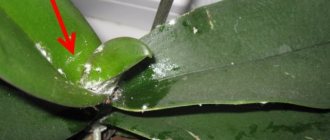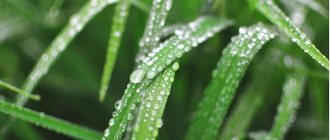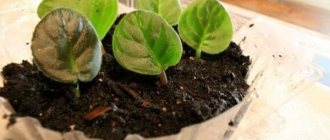Zantedeschia: plant features
Each flower has its own characteristics and care requirements, and Zantedeschia is no exception. Its main feature is that it can be grown in the garden, or at home. But no matter what growing method you choose, you need to remember a few rules for caring for the plant:
- To prevent the roots from rotting, they only need to be lightly sprinkled with soil and not deepened;
- Few people know that what we are accustomed to thinking of as a calla flower is actually not one. This is just a leaf that protects the flower from mechanical damage. Calla flowers are very small, although they have an incredibly strong and pleasant aroma;
- calla germinates for a very long time, because first it completely forms its root system, and only then shoots appear. This may take up to 30 days;
- if you decide to replant a flower, then use extreme caution when digging up the tubers as they are very easy to damage;
- If you notice small droplets at the tips of the leaves, then be prepared for the fact that it will rain soon. Before the rain, the flower always looks as if drops have already fallen on it. This applies to both garden and indoor Zantedeschia;
- pay special attention to choosing a pot for calla lilies. It is better if it is a porous pot, which will allow excess moisture to quickly evaporate. This point is especially important if you decide to grow Ethiopian calla lilies;
- The flowering period of each Zantedeschia flower is 30 days;
- Periodically it is necessary to replace the top layer of soil in the pot with fresh one.
If you follow all these simple rules, you will be able to grow a healthy and beautiful flower in your garden.
Causes of grayish-white stool
Errors in diet
The discharge of gray feces in adults is observed after excessive consumption of fatty foods.
Excessive amounts of neutral fats accumulate in the intestines; due to the increased load on the pancreas, lipids are not digested and are excreted in the feces. The consistency changes - the feces become soft, “greasy”, leaving marks on the walls of the toilet. Typically, stool frequency increases up to 3-4 times a day. Usually the symptoms disappear on their own, and the color of the stool normalizes the very next day. The reasons that provoke the passage of grayish-white stool in infants are improper introduction of complementary foods, the use of unbalanced milk formulas. Changes in the color of feces occur against the background of general weakness and lethargy of the child, constant crying and refusal to feed. These symptoms are an indication for consultation with a pediatrician.
Dysbacteriosis
Violation of the composition of the intestinal microflora causes digestive disorders and insufficient digestion of incoming food. The stool becomes liquid and grayish-white or dark gray in color. The frequency of stool with dysbacteriosis increases to 5-7 times a day, defecation is preceded by spasms and discomfort in the left abdomen. The stool has a foul odor and a light gray coating can be seen on the surface.
Hepatitis
Infectious causes cause destruction of liver cells and disturbances in bilirubin metabolism, which reduces the flow of stercobilin into the intestines, which colors stool brown. Gray feces appear at the height of hepatitis; the symptom is combined with a sharp darkening of the urine and yellowing of the skin. An increase in stool frequency and a change in its consistency are typical; before defecation, patients feel rumbling and “bubbling” in the abdomen.
The duration of the symptom depends on the type of liver inflammation. In mild forms of viral hepatitis A and E, grayish-white stool discharge persists for 2-3 weeks. With hepatitis B, the color of stool returns to normal after 1-2 months; in case of severe damage to the liver parenchyma, dark gray feces are excreted for up to six months. Alcoholic hepatitis, complicated by damage to the pancreas, often causes persistent lightening of the stool.
Cholelithiasis
The discharge of grayish-white feces indicates an exacerbation of cholelithiasis and blockage of the bile duct with a stone. In this case, bile does not enter the intestines, and symptoms of obstructive jaundice develop. The person notices that the stool becomes light, almost white, and the consistency of the stool often remains normal. Discoloration of the stool occurs simultaneously with severe pain in the right hypochondrium, nausea, and bitterness in the mouth.
Pancreatitis
A change in the color of stool to white in adults occurs with chronic pancreatitis, which is characterized by enzyme deficiency of the pancreas. The light color is due to the accumulation of undigested food in the feces. The stool is copious, grayish-white in color, with a strong fetid odor. There is an increase in stool frequency; during defecation, patients experience diffuse abdominal pain.
Disorders of pancreatic function are often irreversible, therefore, without prescribing replacement therapy, restoration of normal stool color is impossible. The patient's condition worsens under the influence of external causes - with the abuse of heavy food, drinking alcohol, the disease worsens. During this period, diarrhea with the release of a large amount of light-colored feces, accompanied by intense pain in the left hypochondrium and epigastrium, is a concern.
Other liver pathologies
Damage to liver cells of various etiologies is accompanied by parenchymal jaundice, which is typically characterized by the appearance of a grayish-white color of stool. Such changes persist for a long time, for several months. Abnormal bowel movements are associated with dull pain and heaviness in the right hypochondrium, nausea and vomiting with bile. Most often, stool discoloration is caused by the following reasons:
- Cirrhosis
: alcoholic, postnecrotic, biliary. - Space-occupying formations
: hepatocellular carcinoma, hydatid cyst, polycystic liver disease. - Functional disorders
: Gilbert's syndrome, Crigler-Najjar syndrome, cholestasis of pregnancy.
Complications of pharmacotherapy
A short-term change in the color of stool to grayish-white is a natural reaction after taking barium sulfate orally for X-rays of the digestive tract. Light-colored stool passes 10-12 hours after the examination; the atypical color of stool persists for 2-3 days. Normally, these changes are not accompanied by dyspeptic disorders or abdominal pain.
Gray feces are also provoked by other reasons: taking antacids, iron. Microelements, which are contained in large quantities in these medications, accumulate in the feces and cause the appearance of a characteristic grayish-white color. When using iron supplements, the color becomes darker, even black. Discoloration of stool is possible with prolonged use of antibiotics and anti-tuberculosis drugs.
Rare causes
- Inflammatory bowel diseases
: Crohn's disease, ulcerative colitis, chronic enteritis. - Celiac disease
. - Malignant tumors
: cancer of the head of the pancreas, cancer of the duodenum. - Bile duct atresia
.
Gallery: calla lilies (25 photos)
Photo gallery
The most popular representatives of the small calla family:
| Variety | Description |
| Nicholas | A very tall plant (1.5 m) with dark green leaves and large green flowers, the diameter of which exceeds 10 cm. A typical outdoor calla lily that looks great and grows in open ground |
| Pearl | Tall plant, up to one and a half meters, with light heart-shaped leaves. The flowers are white, with a slight greenish coating on the reverse side. The culture is potted, but can also be grown in open ground |
| Schone Zweibrückerin | A plant up to 1 meter high with light heart-shaped leaves and dark green flowers with a slight light waxy coating. The diameter of the flower cover reaches 15 cm. This variety can be grown both in a pot and in open ground |
| Green goddess | One of the most beautiful varieties, famous for its unusually large and bright green funnel-shaped flowers. Grows up to 90 cm in height, good in open ground and in pots, as an indoor form |
| Chameleon | Potted low calla lily with incredibly beautiful peach-golden flowers |
| Evening | A unique variety with dark flowers that can be black-blue or black-lilac, sometimes with a purple border visible on the flowers |
| Indian summer | A compact plant with a very bright flower-veil of bright red color with a garnet bloom. |
| Mango | A compact variety with a bright red veil, which is mottled with yellowish strokes |
| Captain Chelsea | A plant with small leaves and a fairly large purple flower, decorated with a yellow border, and occasionally with red-purple spots along the edge of the flower. |
| Bolero | A small bush with bright green leaves and a deep crimson flower with a dark pink base. |
In almost all of the varieties described, the cob with seeds is yellow. However, there are specimens with other color options. However, after flowering and seed set, the ear of all varieties appears green or yellowish-green.
Growing in the garden
Many gardeners enjoy planting Zantedeschias in their gardens. Their flower stalks add majesty to every garden. And since the plant is a perennial, the rhizomes produce new shoots every year.
Callas prefer open space in fertile soil. But if the summer is too hot, the flowers should be shaded. This is due to the fact that the scorching sun is extremely dangerous for their delicate leaves and peduncles. It literally burns them.
Choose places for planting these flowers so that there are trees nearby, the shadow of which will fall on the flower bed with callas in the afternoon. When choosing soil, make sure that it is fairly acidic. Rhizomes do not like stagnant moisture, so you should prepare good drainage for them in advance. You can prepare the soil for calla lilies yourself. To do this you will need:
- sand;
- Earth;
- peat;
- leaf humus.
All these components must be taken in equal proportions. Mix and form a flower bed.
Features of growing garden calla lilies
Callas will be an excellent decoration for any garden, as they have an unusually decorative appearance. The places where these flowers grow are similar to Arabic ornamental painting. Every year they grow new spectacular leaves, and the main decoration appears - an arrow-peduncle...
This plant needs a fairly large open area. It prefers soil rich in nutrients. However, it is recommended to shade it from the scorching direct rays of the sun, as they can burn the foliage. In this regard, it is recommended to plant calla lilies in close proximity to shrubs or trees. Fertile soil should be acidic or slightly acidic. It should also be well-drained, since if the tubers are constantly waterlogged, this can destroy the plant. The most suitable soil mixture for planting is sand, leaf humus, soil and peat, which must be combined in equal proportions.
Planting and care
The most suitable time for planting calla lilies is considered to be the beginning of May. Before planting, you need to prepare the soil and drainage in advance, and then prepare the tubers. They are kept for half an hour in a solution of potassium permanganate. If there are rotten places on the tubers, you should carefully remove them with a knife. The resulting wounds must be covered with brilliant green so that the damage does not begin to spread further.
Buy complex fertilizer and apply it to the soil at the rate of 30-40 grams per square meter. Then the fertilized area should be dug up and the holes prepared. Tubers are placed at a distance of 30-40 centimeters from each other and to a depth of no more than ten centimeters.
Diagnostics
A gastroenterologist is involved in identifying the cause of gray stool. The specialist collects anamnesis and complaints to determine why dyspeptic disorders appeared. Diagnostics includes instrumental visualization methods, which, if indicated, are supplemented with invasive techniques. To clarify the diagnosis, laboratory tests are prescribed. The most informative methods:
- Coprogram
. Microscopic analysis of grayish-white stool reveals remains of undigested food, muscle fibers, and starch grains. The absence of stercobilin is pathognomonic. To confirm the diagnosis of pancreatitis, a fecal elastase level test is performed. Bacteriological analysis is necessary to identify dysbiosis and bacterial overgrowth syndrome. - Blood chemistry
. With obstructive jaundice, cholestasis syndrome is determined - an increase in the amount of cholesterol and the enzyme alkaline phosphatase. An increase in ALT and AST levels indicates cytolysis and parenchymal jaundice. To test the exocrine function of the pancreas, the concentration of pancreatic lipase and amylase is measured. - Ultrasonography
. In order to detect the organic cause of a grayish-white stool, a survey ultrasound of the abdominal cavity is performed with targeted scanning of the organs of the hepatobiliary zone. The study allows you to visualize signs of the inflammatory process of the gallbladder, heterogeneous echogenicity of the liver parenchyma, and rounded volumetric neoplasms. - Duodenal sounding
. To assess the flow of bile into the intestine, several portions of bile are taken sequentially after stimulation with secretory drugs. Typically there is a slow release of bile or its complete absence in case of blockage of the common bile duct. The collected material is sent to the laboratory for bacteriological analysis. - Cholangiopancreatography
. White feces usually appear when the biliary tract is damaged, so RCCP is required. The method involves examining the papilla of Vater and bile ducts using endoscopic technologies. The study reveals stones in the bile ducts, signs of inflammatory and tumor pathologies.
White callas at home
If you decide to grow calla lilies at home, then you need to take care in advance of the place where the flower will grow. This should be a well-lit place, but without direct sunlight. The temperature in the room in summer should be from 22 to 25 degrees, and in winter it should not fall below 14 degrees.
The soil for home calla lilies should be quite acidic and nutritious; it’s good if you add peat and sawdust to it. Select a pot approximately 25 centimeters in diameter. The tuber should be quite large. With the convex side it is placed in a pot 5 centimeters into the soil. When the tuber is covered with soil, it is necessary to water it with fungicide on top.
Homemade calla lilies, like garden ones, do not require special care. She also does not like excess moisture. Too much water can cause the tuber to rot.
Diseases that cause stool discoloration
If a person does not consume excessive amounts of fats and alcohol, maintains a balanced diet, leads an active lifestyle, does not take any medications, and the stool still turns white, then you should immediately consult a doctor for advice.
If you do not do this on time, you may miss the onset of the development of such dangerous diseases as stomach cancer, hepatitis, intestinal cancer, pancreatitis, cholelithiasis, and pancreatic cancer.
Sometimes it is not the color of stool itself that signals the presence of a disease; it happens that the stool is covered with a white coating or white mucus; grains and dots of white color can occur periodically or be constant companions of the stool. Each of these signs can give the doctor a lead on how to identify the disease and what the diagnosis might be.
If a person's diet is rich in plant products, white fibers will be found in the feces.
Sometimes this is also a sign that the gastrointestinal tract is not working properly and is processing food untimely and incompletely.
Feces can turn white when helminths colonize the human body. These parasites contribute to an imbalance of digestive enzymes and also inhibit intestinal microflora.
Roundworms can cause light-colored stools
If there are white lumps in the stool (and this most often happens in a child under one year old), this indicates the immaturity of the digestive system, or a malfunction in its functioning in adults. If children also have foam and loose stools added to such white grains, this indicates that the formula for feeding is not suitable for the baby and it needs to be replaced. This is common in artificial babies.
A separate symptom is the presence of white mucus in the stool.
Normally, mucus should be present in a person’s intestines. It promotes the gentle movement of feces through the intestines, preventing the appearance of cracks due to excessively hard feces and rough, dry intestinal walls.
Mucus is usually not noticeable in the stool, but if there is a lot of it or it becomes a clear white color, then you need to find out why this happened.
Sometimes this happens with a large consumption of bananas and melons, as well as cottage cheese, sour cream and milk.
But if this option is excluded, then the body should be diagnosed.
White mucus in the stool can be a symptom of a disease, namely:
- diverticulitis;
- bowel cancer;
- intestinal polyposis;
- individual lactose intolerance;
- cystic fibrosis;
- irritable bowel syndrome.
If you find white mucus in your or your child's stool, be sure to consult your doctor about this to find out what disease it occurs with.
Polyps in the intestines
Flower propagation
There are three ways to propagate calla lilies:
- seeds (unreliable method);
- tubers;
- dividing the bush.
If you decide to propagate callas by dividing the bush, then in the fall, when you dig up the bushes, the offspring, along with the rhizome, are separated from the general bush and placed in a special pot with soil. In the spring, this seedling is transplanted into open ground. But this method of reproduction is only suitable for Ethiopian calla lilies and its subspecies. All other types of calla lilies reproduce by tubers. To do this, in the fall, after flowering, the tubers are dug up and placed in a dry place until spring.
Calla flowers - types
Calla lilies can be divided into two groups: tree-like and deciduous (Eliota and Remani).
Calla Amethyst
This variety has lilac flowers like the color of a violet. The unforgettable smell of the sea will delight you in your home. Some varieties have a white (cream) flower in appearance. The height of the bush reaches 120 cm. Flowering lasts for at least 2 months. The long peduncle has always been popular for decorating palaces.
Calla Vermeer
A white blanket with a pinkish tint in the middle looks great in combination with a bright lemon cob growing from the center, creating a unique ornament, especially in composition with other flowers. Green decorative leaves interspersed with white add even more charm to the flower. This species does not exceed 60 cm.
Calla Remanna
A gentle pink blanket seems to wrap a yellow cob. Some hybrid forms are found with dark-colored flowers in shades of red and pink. The height reaches 50 cm. From this species, breeders have bred many hybrid forms of variegated flowers.
Calla Elliott
Basically the flower consists of a yellow spathe and a red border on the outside. Heart-shaped leaves with numerous white spots. It reaches a height of 50 cm. It grows well on windowsills and prefers a lot of light.
Use in landscape design
Large white flowers look great as a frame for wide garden paths. At the same time, low-growing hostas or even marigolds can be planted between them and the border. Moisture-loving ground covers will be good company for them. White callas are also excellent as decoration for areas near water bodies.
Colored varieties are good in single plantings; they also provide good shade for arrays of decorative foliage plants. It is recommended to place plants not individually, but in small groups of 3-7 bushes. Colored callas are also good as a frame for garden paths.









